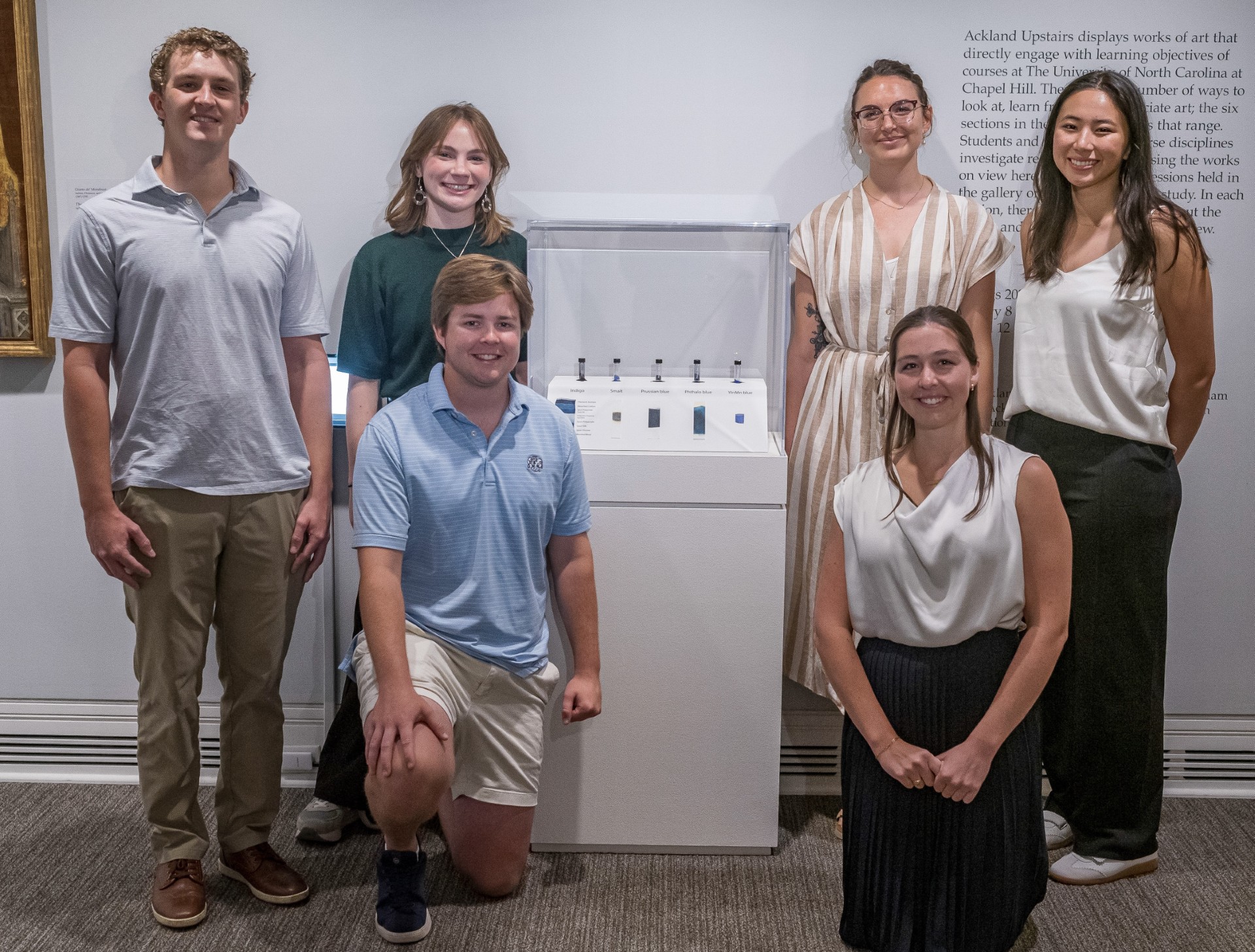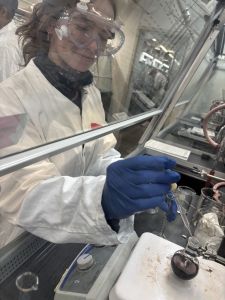In Redesigned Chemistry Course, Students Turn Pigments into Art Preservation Tools

Dr. Jade Fostvedt, standing second from right, a teaching assistant professor, has created a new course, “Chemistry, Conservation, and CURE: Pigments and Dyes of Antiquity,” and its goal is as colorful as its subject matter: give undergraduates a real-world research experience while contributing to the preservation of cultural heritage at UNC’s Ackland Art Museum. Beside her, standing left to right, are recently graduated chemistry students: Emerson Woolwine, Torrance (Tori) Jenkins and Dylan McEldowney, and kneeling, Philip Garside and Lilly Gornto.

May 19, 2025 I By Dave DeFusco
In the UNC Chemistry Department, a new kind of experiment is taking shape—one that melds the rigor of synthetic chemistry with the beauty of art conservation. At the heart of this innovation is Dr. Jade Fostvedt, a teaching assistant professor who has spent the past year redesigning the department’s senior capstone course, CHEM 550L: Synthetic Chemistry Laboratory, into a deeply interdisciplinary, research-driven experience.
The new course, “Chemistry, Conservation, and CURE: Pigments and Dyes of Antiquity,” was launched in Spring 2025 with a record enrollment of 71 chemistry majors. And its goal is as colorful as its subject matter: give undergraduates a real-world research experience while contributing to the preservation of cultural heritage at UNC’s Ackland Art Museum.
“The interface between chemistry and art is rich in connections,” said Fostvedt. “We want students to discover those connections not just in the lab, but while walking the museum galleries, thinking about history, culture and the chemistry that holds it all together.”
CHEM 550L has long served as a foundational course for senior chemistry majors—an opportunity to synthesize knowledge through independent research. But until now, the CURE (Course-based Undergraduate Research Experience) component had remained largely unchanged since its inception in 2019. Students worked on catalyst design, a useful but isolated task.
Fostvedt saw the chance for something more dynamic. She partnered with Dr. Michel Gagné, a synthetic chemist; Dr. Kathleen Nevins and Dr. Tyler Motley, both lab curriculum specialists; and experts from the Ackland Art Museum to build a new vision. That vision was supported with funding from the UNC System Undergraduate Research Program Award, making possible a full revamp of CHEM 550L into a living, evolving, multidisciplinary course.
In the first half of the semester, students synthesized five historical and culturally significant blue pigments—Prussian blue, phthalo blue, smalt, indigo and the modern YInMn blue. These vibrant compounds were chosen not just for their Carolina-blue relevance but for their deep roots in both ancient and contemporary art traditions.
Students learned to quantitatively analyze color, determine what gives molecules their hues and investigate synthetic routes to both ancient and never-before-seen pigments. “These pigments span the full range of chemistry,” said Fostvedt, “from organic to inorganic compounds and even solid-state materials, which is a new frontier for our department.”
As an offshoot of the course, senior chemistry major Clara Lord collaborated with Fostvedt and Grace White, paper conservator at the Ackland Art Museum, to use infrared photography and spectral imaging to analyze unknown pigments in artworks from the Ackland. The museum, whose collection is more than 80% works on paper, had previously only analyzed a small fraction of its collection due to resource limitations.
Now, thanks to this partnership, students contribute directly to conservation science, helping identify unstable pigments and understand their long-term behavior—critical for preserving delicate paper-based artworks vulnerable to light, air and time.
The second half of the course challenged students to take their work to the next level. Working in teams of four, they designed original research questions, including: How does the choice of copper source influence the color and structure of Egyptian blue pigments? Can organic-inorganic hybrid pigments like Maya blue be adapted to produce other colors? How do electron-withdrawing or -donating groups alter the color of indigo-based dyes?
With support from Dr. Josh Chen of the Chemistry X-Ray Core Lab and Dr. Bob Geil of the Chapel Hill Analytical and Nanofabrication Laboratory, students accessed advanced instrumentation, like powder X-ray diffraction and energy-dispersive X-ray spectroscopy, to analyze their creations and trace elements in museum samples.
For many students, it was their first time conducting truly independent research—and the experience was transformative. Being able to see their pigments showcased in artworks the Ackland’s collection and then to have their own lab-synthesized creations on display made them feel like their work mattered. It wasn’t just a class; it was a contribution.
Beyond the technical skills, Fostvedt’s course encourages belonging. By using art—a subject that connects deeply with culture and identity—she hopes to draw a more diverse array of students into chemistry and keep them there.
“We want students to see themselves in the science,” she said. “Whether that means studying pigments from indigenous traditions or exploring dyes linked to their own heritage, art allows us to personalize the lab in a way traditional experiments don’t.”
It’s part of a larger movement in STEM to not only teach content but to cultivate inclusion. Research shows that when students can connect their learning to personal or cultural experiences, their engagement—and retention in the field—increases.
Dr. Elizabeth Manekin, head of university programs and academic projects at the Ackland, is already curating exhibitions to support future classes, and the museum has plans to showcase student findings in upcoming displays—a literal gallery of student scholarship.
“Through our collaboration,” said Fostvedt, “we’re not just training chemists. We’re training thoughtful scientists who can communicate across disciplines, solve complex problems and recognize the value of their work in the world around them.”

